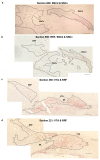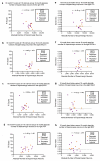A Novel Rat Model of ADHD-like Hyperactivity/Impulsivity after Delayed Reward Has Selective Loss of Dopaminergic Neurons in the Right Ventral Tegmental Area
- PMID: 37511013
- PMCID: PMC10379272
- DOI: 10.3390/ijms241411252
A Novel Rat Model of ADHD-like Hyperactivity/Impulsivity after Delayed Reward Has Selective Loss of Dopaminergic Neurons in the Right Ventral Tegmental Area
Abstract
In attention deficit hyperactivity disorder (ADHD), hyperactivity and impulsivity occur in response to delayed reward. Herein we report a novel animal model in which male Sprague-Dawley rats exposed to repeated hypoxic brain injury during the equivalent of extreme prematurity were ADHD-like hyperactive/impulsive in response to delayed reward and attentive at 3 months of age. Thus, a unique animal model of one of the presentations/subtypes of ADHD was discovered. An additional finding is that the repeated hypoxia rats were not hyperactive in the widely used open field test, which is not ADHD specific. Hence, it is recommended that ADHD-like hyperactivity and ADHD-like impulsivity, specifically in response to delayed reward, be a primary component in the design of future experiments that characterize potential animal models of ADHD, replacing open field testing of hyperactivity. Unknown is whether death and/or activity of midbrain dopaminergic neurons contributed to the ADHD-like hyperactivity/impulsivity detected after delayed reward. Hence, we stereologically measured the absolute number of dopaminergic neurons in four midbrain subregions and the average somal/nuclear volume of those neurons. Repeated hypoxia rats had a significant specific loss of dopaminergic neurons in the right ventral tegmental area (VTA) at 2 weeks of age and 18 months of age, providing new evidence of a site of pathology. No dopaminergic neuronal loss occurred in three other midbrain regions. Fewer VTA dopaminergic neurons correlated with increased ADHD-like hyperactivity and impulsivity. Novel early intervention therapies to rescue VTA dopaminergic neurons and potentially prevent ADHD-like hyperactivity/impulsivity can now be investigated.
Keywords: ADHD hyperactive/impulsive presentation; fixed-interval extinction test; midbrain dopaminergic neurons; open field test; stereology; ventral tegmental area.
Conflict of interest statement
The authors declare no conflict of interest.
Figures









Similar articles
-
A Risk Factor for Attention Deficit Hyperactivity Disorder Induces Marked Long-Term Anatomical Changes at GABAergic-Dopaminergic Synapses in the Rat Ventral Tegmental Area.Int J Mol Sci. 2024 Dec 2;25(23):12970. doi: 10.3390/ijms252312970. Int J Mol Sci. 2024. PMID: 39684680 Free PMC article.
-
ADHD-like hyperactivity, with no attention deficit, in adult rats after repeated hypoxia during the equivalent of extreme prematurity.J Neurosci Methods. 2007 Nov 30;166(2):315-22. doi: 10.1016/j.jneumeth.2007.01.010. Epub 2007 Jan 21. J Neurosci Methods. 2007. PMID: 17346800
-
Temporally Specific Roles of Ventral Tegmental Area Projections to the Nucleus Accumbens and Prefrontal Cortex in Attention and Impulse Control.J Neurosci. 2021 May 12;41(19):4293-4304. doi: 10.1523/JNEUROSCI.0477-20.2020. Epub 2021 Apr 9. J Neurosci. 2021. PMID: 33837050 Free PMC article.
-
Expression of receptors for insulin and leptin in the ventral tegmental area/substantia nigra (VTA/SN) of the rat: Historical perspective.Brain Res. 2016 Aug 15;1645:68-70. doi: 10.1016/j.brainres.2015.12.041. Epub 2015 Dec 28. Brain Res. 2016. PMID: 26731335 Review.
-
VTA GABA Neurons at the Interface of Stress and Reward.Front Neural Circuits. 2019 Dec 5;13:78. doi: 10.3389/fncir.2019.00078. eCollection 2019. Front Neural Circuits. 2019. PMID: 31866835 Free PMC article. Review.
Cited by
-
Rehmanniae Radix Preparata ameliorates behavioral deficits and hippocampal neurodevelopmental abnormalities in ADHD rat model.Front Neurosci. 2024 May 30;18:1402056. doi: 10.3389/fnins.2024.1402056. eCollection 2024. Front Neurosci. 2024. PMID: 38872946 Free PMC article.
-
An updated review on animal models to study attention-deficit hyperactivity disorder.Transl Psychiatry. 2024 Apr 11;14(1):187. doi: 10.1038/s41398-024-02893-0. Transl Psychiatry. 2024. PMID: 38605002 Free PMC article. Review.
-
A Risk Factor for Attention Deficit Hyperactivity Disorder Induces Marked Long-Term Anatomical Changes at GABAergic-Dopaminergic Synapses in the Rat Ventral Tegmental Area.Int J Mol Sci. 2024 Dec 2;25(23):12970. doi: 10.3390/ijms252312970. Int J Mol Sci. 2024. PMID: 39684680 Free PMC article.
References
-
- American Psychiatric Association . Diagnostic and Statistical Manual of Mental Disorders: DSM-V. 5th ed. American Psychiatric Association; Arlington, VA, USA: 2013.
MeSH terms
Grants and funding
LinkOut - more resources
Full Text Sources
Medical

